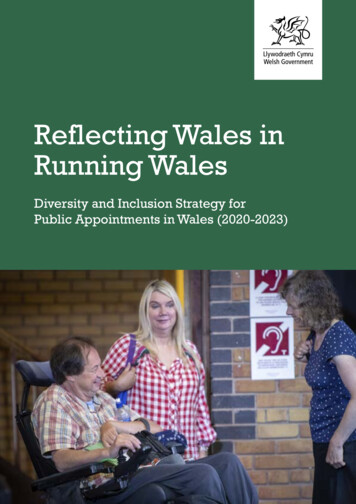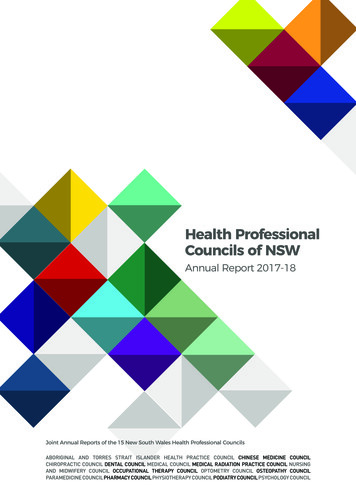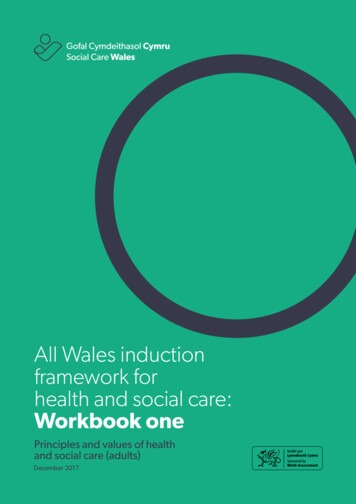
Transcription
ed for accessing the internet by this group of children was a tablet or handheld device(used by 71%).Chart 1: Devices children used to access the internet at blet orhandhelddeviceLaptopMobile phoneor smartphoneGamesconsoleDesktopcomputerDigital TVDevices child uses to access the internet at homeChildren are given increasingly more homework that requires them to access the internet, and forwhich using a laptop or desktop computer may be best. Parents of the 34% of children who did notuse a laptop or desktop computer at home were therefore asked whether their child used theinternet anywhere else outside of school. 42% of these children used the internet at anotherperson’s home, and 10% used the internet in a public building, such as a library or communitycentre.Chart 2 shows that the percentage of children who used a mobile phone or a smartphone toaccess the internet at home increased sharply with age. 25% of children aged 7-10 who accessedthe internet at home used a mobile phone or smartphone, compared with 71% of children aged 1415.Chart 2: Mobile phone or smartphone used to access the internet, by age of child80%71%60%59%40%20%25%0%7-1011-1314-15Age of child3
Parents of children who used the internet outside school were asked about which activities theirchild used the internet for. Chart 3 shows that, according to parents, 64% of children used theinternet to access school learning platforms and 67% of children used the internet to find otherinformation related to schoolwork. The percentage of children using the internet for school-relatedactivities increased with the age of the child. At age 7-10, 23% of children used the Hwb schoollearning platform, and 62% used the internet for finding other information related to schoolwork.For children aged 14-15, this increased to 33% accessing Hwb, and 73% using the internet to findother information related to schoolwork.Other common internet activities included online gaming (46%) and social networking (41%).Chart 3: Internet activities carried out by child80%67%60%64%40%46%41%20%0%Finding otherinformation related toschoolworkSchool learningplatformsOnline gamingSocial networking41% of all children aged 7-15 used the internet for social networking, however this varied greatlyby age. Chart 4 shows that while 8% of children aged 7-10 used the internet for social networking,this percentage increased to 84% for children aged 14-15, making social networking the mostpopular internet activity for this age group. The majority of social networking services state aminimum age of 13 in their terms and conditions, but the results show that children are using theinternet for social networking before they are 13. Parents indicated that 32% of children aged 11used the internet for social networking, increasing to 58% of children aged 12, and 77% of childrenaged 13.Details of the specific websites or services used were not collected. Generally boys and girlscarried out the same online activities and to a similar extent. However, 60% of boys used theinternet for online gaming, compared with 32% of girls.4
Chart 4: Use of internet for social networking by age of child100%80%84%60%56%40%20%8%0%7-1011-1314-15Age of childInternet safetyParents were asked whether their household used parental control filters, such as ‘Net Nanny’ orother filters provided by their internet service provider (ISP). As shown in Chart 5, 56% ofhouseholds with children used parental control filters, 32% did not use filters, and 12% had neverheard of internet filters.Chart 5: Use of parental control filters60%56%50%40%30%32%20%10%12%0%No – never heard of themNo – heard about them but donot use themYesHouseholds with more children were more likely to use a parental control filter. While 52% ofhouseholds with one child used a filter, this increased to 62% for households with 3 or morechi ribution of the final datasetmatches that of the Welsh population).Quality of the dataNational Statistics statusThe United Kingdom Statistics Authority has designated these statistics as National Statistics, inaccordance with the Statistics and Registration Service Act 2007 and signifying compliance withthe Code of Practice for Official Statistics.National Statistics status means that official statistics meet the highest standards oftrustworthiness, quality and public value.All official statistics should comply with all aspects of the Code of Practice for Official Statistics.They are awarded National Statistics status following an assessment by the UK StatisticsAuthority’s regulatory arm. The Authority considers whether the statistics meet the higheststandards of Code compliance, including the value they add to public decisions and debate.9
It is Welsh Government’s responsibility to maintain compliance with the standards expected ofNational Statistics. If we become concerned about whether these statistics are still meeting theappropriate standards, we will discuss any concerns with the Authority promptly. National Statisticsstatus can be removed at any point when the highest standards are not maintained, and reinstatedwhen standards are restored.Quality reportA summary quality report is available, containing more detailed information on the quality of thesurvey as well as a summary of the methods used to compile the results.Sampling variabilityEstimates from the National Survey are subject to a margin of uncertainty. Part of the uncertaintycomes from the fact that any randomly-selected sample of the population will give slightly differentresults from the results that would be obtained if the whole population was surveyed. This isknown as sampling error.4 Confidence intervals can be used as a guide to the size of the samplingerror. These intervals are calculated around a survey estimate and give a range within which thetrue value is likely to fall. In 95% of survey samples, the 95% confidence interval will contain the‘true’ figure for the whole population (that is, the figure we would get if the survey covered theentire population). In general, the smaller the sample size the wider the confidence interval.Confidence intervals are included in the tables of survey results published on StatsWales.As with any survey, the National Survey is also subject to a range of other sources of error: forexample, due to non-response; because respondents may not interpret the questions as intendedor may not answer accurately; and because errors may be introduced as the survey data isprocessed. These kinds of error are known as non-sampling error, and are discussed further in thequality report for the survey.Significant differencesWhere the text of this release notes a difference between two National Survey results (in the sameyear), we have checked to ensure that the confidence intervals for the two results do not overlap.This suggests that the difference is statistically significant (but as noted above, is not as rigorousas carrying out a formal statistical test), i.e. that there is less than a 5% (1 in 20) chance ofobtaining these results if there is no difference between the same two groups in the widerpopulation.Checking to see whether two confidence intervals overlap is less likely than a formal statistical testto lead to conclusions that there are real differences between groups. That is, it is more likely tolead to "false negatives": incorrect conclusions that there is no real difference when in fact there isa difference. It is also less likely to lead to "false positives": incorrect conclusions that there is adifference when there is in fact none. Carrying out many comparisons increases the chance offinding false positives. Therefore, when many comparisons are made the conservative nature ofthe test is an advantage because it reduces (but does not eliminate) this chance.4Sampling error is discussed in more detail in the Quality Report for the National Survey.10
Where National Survey results are compared with results from other sources, we have not checkedthat confidence intervals do not overlap.Regression analysisMore details on how we did the regression analysis in this report, and on the regression model thatwas produced, are available in this Technical Report.Technical reportMore detailed information on the survey methodology is set out in the technical report for thesurvey.Well-being of Future Generations Act (WFG)The Well-being of Future Generations Act 2015 is about improving the social, economic,environmental and cultural well-being of Wales. The Act puts in place seven well-being goals forWales. These are for a more equal, prosperous, resilient, healthier and globally responsible Wales,with cohesive communities and a vibrant culture and thriving Welsh language. Under section(10)(1) of the Act, the Welsh Ministers must (a) publish indicators (“national indicators”) that mustbe applied for the purpose of measuring progress towards the achievement of the Well-beinggoals, and (b) lay a copy of the national indicators before the National Assembly. The 46 nationalindicators were laid in March 2016.Information on indicators and associated technical information - How do you measure a nation’sprogress? - National IndicatorsFurther information is available - Well-being of Future Generations (Wales) Act 2015.Although the statistics included in this release do not contribute directly to any of the indicatorsthey could provide supporting narrative to the national indicators and be used by public servicesboards in relation to their local well-being assessments and local well-being plans.RevisionsMore information on our revisions policy.Release policyInformation about the process for releasing new results is available from the Welsh Government’sstatistics web pages.Availability of datasetsThe data behind the charts and tables in this release are published in spreadsheets onStatsWales. An anonymised version of the annual datasets (from which some information isremoved to ensure confidentiality is preserved), together with supporting documentation, has beendeposited with the UK Data Archive. For more information, please contact us (see below).11
Further uses of the resultsThe results will be used extensively by Welsh Government policy teams, but they are also relevantto a wide range of other external organisations and individuals.Next updateNot a regular output.Further detailsThe document is available al-survey/?tab current&lang enWe want your feedbackWe welcome any feedback on any aspect of these statistics which can be provided by email tosurveys@wales.gsi.gov.ukOpen Government LicenceAll content is available under the Open Government Licence v3.012
Parents were asked whether their household used parental control filters, such as 'Net Nanny' or other filters provided by their internet service provider (ISP). As shown in Chart 5, 56% of households with children used parental control filters, 32% did not use filters, and 12% had never heard of internet filters.











